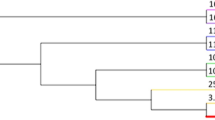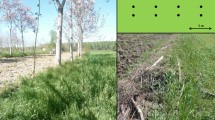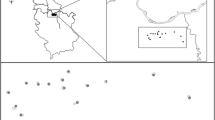Summary
Does the response of insect herbivores to the spatial dispersion of their food plants depend on whether alternative dispersions are available? To answer this question, four quartets of collard plots (Brassicae oleracae) were planted. Quartets contained two pairs of plots representing alternative planting designs. In one pair the alternatives were separated from one and other by a curtain barrier that effectively prevented plot to plot movement by the flea beetle, Phyllotreta cruciferae. The boundary between the other pair of alternatives was without barriers, and the beetles could range freely between these two plots. We hypothesized that the presence of a choice (i.e. the absence of a barrier) would exaggerate any differences in beetle numbers between the alternative plant arrangements.
Beetles were given “choices” between two kinds of alternatives. In two quartets, the alternatives were high density collard monocultures versus low density collard monocultures. In the other two quartets, the alternatives were collard monocultures versus collard-potato discultures. In each quartet, the abundances of P. cruciferae were censused weekly for three weeks.
As we hypothesized, the influence of cropping pattern (both diversity and density) was less where there was a barrier between cropping alternatives than where there was no barrier between the same alternatives. This suggests that nonrandom foraging movement, or “patch choice”, explains the response of Phyllotreta to cropping treatments. The consequence of this mechanism for interpreting the results of insect-host experiments are substantial; experimental designs allowing insects to move and accumulate in a preferred treatment may have different results from the same treatments in isolation.
Similar content being viewed by others
References
Altieri MA, Letourneau DK (1982) Vegetation management and biological control in agroecosystems. Crop Prot 1:405–430
Andow D (1983) The extent of monoculture and its effects on insect pest populations with particular reference to wheat and cotton. Agricultural Ecosystems and Environments 9:25–35
Bach CE (1980) Effect of plant diversity and time of colonization on an herbivore-plant interaction. Oecologia (Berlin) 44:319–326
Bach CE (1981) Host plant growth form and diversity: effects on abundance and feeding preference of a specialist herbivore Acalymma vittata (Coleoptera: Chrysomelidae). Oecologia (Berlin) 50:370–375
Bach CE (1984) Plant spatial pattern and herbivore population dynamics: plant factors affecting the movement patterns of a tropical cucurbit specialist (Acalymma innubum). Ecology 65:175–190
Bach CE (1986) A comparison of the response of two tropical specialist herbivores to host plant patch size. Oecologia (Berlin) 68:580–584
Balliddawa CW (1985) Plant species diversity and crop pest management. Insect Sci Applic 6:479–487
Cromartie J (1975) The effect of stand size and vegetational background on the colonization of cruciferous plants by herbivorous insects. J Appl Ecol 12:517–533
Cromartie J (1981) The environmental control of insects using crop diversity. In: Pimentel D (ed) CRC Handbook of Pest Management in Agriculture. CRC Press, Boca Raton Florida, pp 223–250
Gould F, Stinner R (1984) Insects in heterogeneous habitats. In: Huffaker C, Rabb R (eds) Ecological entomology, John Wiley & Sons, NY, pp 427–450
Kareiva P (1982) Experimental and mathematical analyses of herbivore movement: quantifying the influence of plant spacing and quality on foraging discrimination. Ecol Monogr 52:261–282
Kareiva P (1983) Influence of vegetation texture on herbivore populations: resource concentration and herbivore movement. In: Denno RF, McClure MS (eds) Variable plants and herbivores in natural and managed systems. Academic Press, NY, pp 259–289
Kareiva P (1985) Finding and losing host plants by flea beetles: patch size and surrounding habitat. Ecology 66:1809–1816
MacArthur R, Pianka E (1966) On the optimal use of a patchy environment. Am Nat 100:603–609
Parker M (1984) Local food depletion and the foraging behavior of a specialist grasshopper, Hesperotettix viridis. Ecology 65:824–835
Pyke G, Pulliam H, Charnov E (1977) Optimal foraging: a selective review of theory and tests. Quart Rev Biology 52:137–154
Risch SJ (1979) A comparison, by sweep sampling, of the insect fauna from corn and sweet potato monocultures and dicultures in Costa Rica. Oecologia (Berlin) 42:195–211
Risch SJ (1981) Insect herbivore abundance in tropical monocultures and polycultures: an experimental test of two hypotheses. Ecology 62:1325–1340
Risch SJ, Andow D, Altieri M (1983) Agroecosystem diversity and pest control: data, tentative conclusions and new research directions. Environ Entomol 12:625–629
Root R (1973) Organization of a plant-arthropod association in simple and diverse habitats: the fauna of collards (Brassica oleracea). Ecol Monogr 43:95–124
Root R (1975) Some consequences of ecosystem texture. In: Levin SA (ed) Ecosystem analysis and prediction. SIAM Press, Philadelphia, PA, pp 83–97
Root R, Kareiva P (1984) The search for resources by cabbage butterflies: ecological consequences and adaptive significance of Markovian movement in a patchy environment. Ecology 65:147–165
Tahvanainen J, Root R (1972) The influence of vegetational diversity on the population ecology of a specialist herbivore, Phyllotreta cruciferae (Coleoptera: Chrysomelidae). Oecologia (Berlin) 10:321–346
Author information
Authors and Affiliations
Rights and permissions
About this article
Cite this article
Bergelson, J., Kareiva, P. Barriers to movement and the response of herbivores to alternative cropping patterns. Oecologia 71, 457–460 (1987). https://doi.org/10.1007/BF00378721
Received:
Issue Date:
DOI: https://doi.org/10.1007/BF00378721




